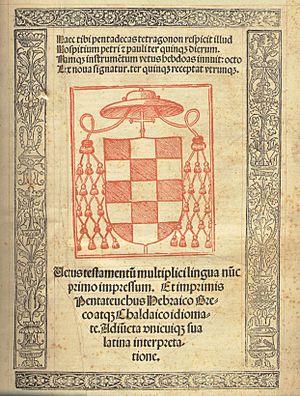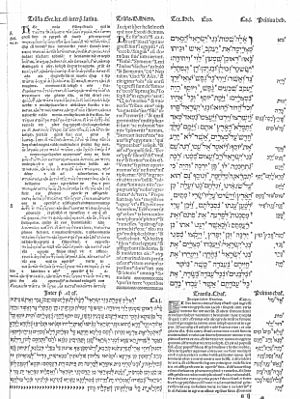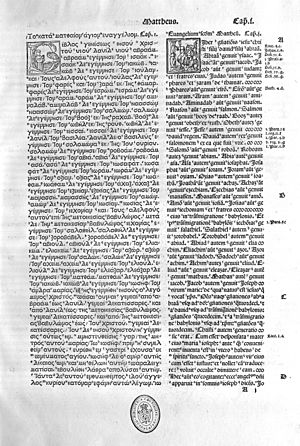Complutensian Polyglot Bible facts for kids
The Complutensian Polyglot Bible is a very special book. It was the first Bible ever printed that included the text in many different languages side-by-side. A "polyglot" means "many languages."
This huge project was started and paid for by a powerful leader named Cardinal Francisco Jiménez de Cisneros (1436–1517). It was printed at Complutense University in Alcalá de Henares, Spain.
This Bible was important because it was the first time the Greek New Testament was printed. It also included the full Septuagint (an old Greek translation of the Old Testament) and the Targum Onkelos (an Aramaic translation of the first five books of the Bible).
Only 600 sets of this six-volume Bible were printed. Today, only 123 of these rare sets are still known to exist!
Contents
How This Bible Was Made
The Idea Behind It
In the past, people often argued about the best way to translate the Bible into different languages, like Castilian Spanish. Cardinal Cisneros hoped that creating a Bible with many original languages side-by-side would help solve these arguments once and for all. He wanted to make sure everyone could see the original texts.
The Translation Team
A brilliant team of scholars worked on this massive project. Diego López de Zúñiga was the main editor. He knew Latin, Aramaic, and Arabic very well.
Many of the translators were "conversos." This means they were Jewish scholars who had converted to Christianity. They were chosen because they knew the original languages, like Hebrew, and understood the cultures of the ancient texts.
One key person was Alfonso de Zamora (1476–1544). He was a converted Jewish scholar and an expert in Talmudic studies (Jewish law and tradition). Hebrew was his first language. Other conversos on the team included Alfonso de Alcalá and Pablo de Coronel.
For the Greek parts, scholars like Demetrius Ducas from Crete, Hernán Núñez de Toledo, and Juan de Vergara were in charge. Antonio de Nebrija was specifically asked to work on the Latin Vulgate (the standard Latin Bible). Hernán Núñez de Toledo was also the main expert in Latin.
All these scholars met and worked together in Alcalá de Henares. This city is near Madrid and was also known by its Latin name, Complutum. This is where the Bible gets its name, "Complutensian."
Printing and Publishing
The New Testament part of the Bible was finished and printed in 1514. However, the team decided to wait to publish it. They wanted to finish the Old Testament first so that the entire Bible could be released as one complete set.
The Old Testament was finally completed in 1517. But there was another delay! A famous scholar named Desiderius Erasmus had a special permission from the Pope to publish his own Greek New Testament first. So, the Complutensian Polyglot Bible had to wait until Pope Leo X gave his approval in 1520.
It is thought that the Bible wasn't widely available until 1522. Sadly, Cardinal Cisneros passed away in July 1517, just five months after the Bible was finished. He never got to see his great work published and distributed.
How It Influenced Others
The Complutensian Polyglot Bible didn't spread as widely as hoped at first. A letter written much later by Philip II of Spain said that many copies were lost in a shipwreck around 1521 while being sent to Italy.
However, its importance was still recognized. Even Desiderius Erasmus mentioned that he used the Complutensian Bible when he worked on his own 1527 edition of the New Testament.
What's Inside
The Complutensian Polyglot Bible came in a set of six large books.
- The first four books contain the Old Testament. On each page, you would see three columns of text side-by-side:
* Hebrew on the outside * The Latin Vulgate in the middle * The Greek Septuagint on the inside
For the first five books of the Bible (the Pentateuch), there was even more! At the bottom of each page, you would find the Aramaic text (the Targum Onkelos) and its own Latin translation.
- The fifth book contains the New Testament. It has two columns: Greek and the Latin Vulgate.
- The sixth book was a helpful study guide. It included dictionaries for Hebrew, Aramaic, and Greek, along with other tools to help scholars understand the texts better.
The Latin version of the Old Testament, created by Jerome, was placed right in the middle of the Greek and Hebrew versions. Some people saw this as a symbol of the Roman Catholic Church being surrounded by the Greek Church and the Jewish people.
See also
- Novum Instrumentum omne
- Editio Regia
- Codex Complutensis I
 In Spanish: Biblia políglota complutense para niños
In Spanish: Biblia políglota complutense para niños




